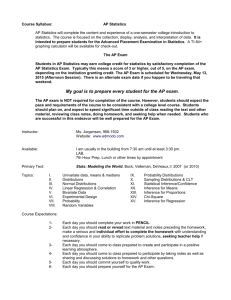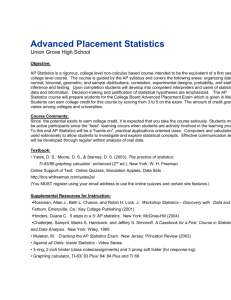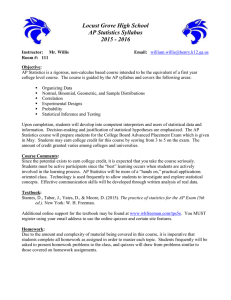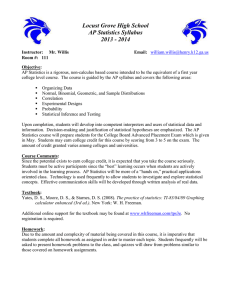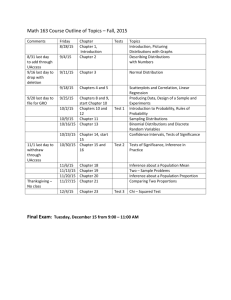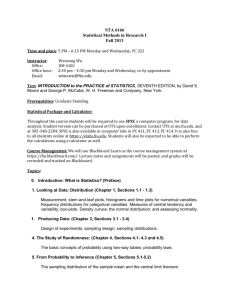File
advertisement
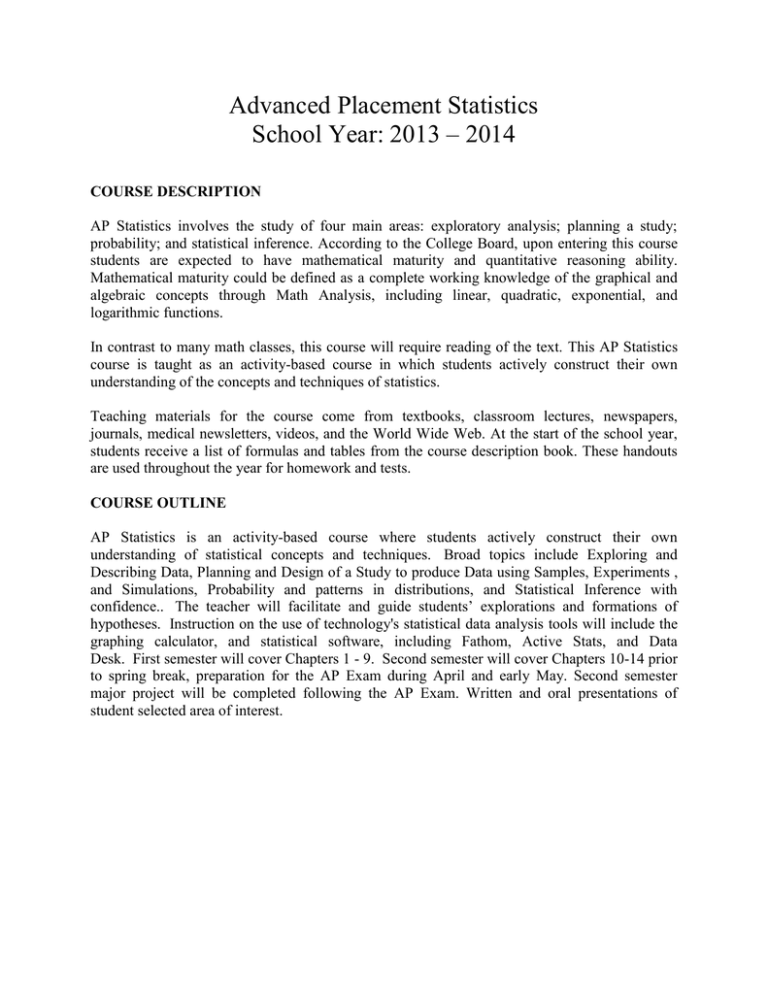
Advanced Placement Statistics School Year: 2013 – 2014 COURSE DESCRIPTION AP Statistics involves the study of four main areas: exploratory analysis; planning a study; probability; and statistical inference. According to the College Board, upon entering this course students are expected to have mathematical maturity and quantitative reasoning ability. Mathematical maturity could be defined as a complete working knowledge of the graphical and algebraic concepts through Math Analysis, including linear, quadratic, exponential, and logarithmic functions. In contrast to many math classes, this course will require reading of the text. This AP Statistics course is taught as an activity-based course in which students actively construct their own understanding of the concepts and techniques of statistics. Teaching materials for the course come from textbooks, classroom lectures, newspapers, journals, medical newsletters, videos, and the World Wide Web. At the start of the school year, students receive a list of formulas and tables from the course description book. These handouts are used throughout the year for homework and tests. COURSE OUTLINE AP Statistics is an activity-based course where students actively construct their own understanding of statistical concepts and techniques. Broad topics include Exploring and Describing Data, Planning and Design of a Study to produce Data using Samples, Experiments , and Simulations, Probability and patterns in distributions, and Statistical Inference with confidence.. The teacher will facilitate and guide students’ explorations and formations of hypotheses. Instruction on the use of technology's statistical data analysis tools will include the graphing calculator, and statistical software, including Fathom, Active Stats, and Data Desk. First semester will cover Chapters 1 - 9. Second semester will cover Chapters 10-14 prior to spring break, preparation for the AP Exam during April and early May. Second semester major project will be completed following the AP Exam. Written and oral presentations of student selected area of interest. Content Map Per Semester Fall Semester Organizing Data Producing Data Probability Weeks 1 - 3 Weeks 10 - Weeks 13 – Weeks 7 - 9 12 14 Weeks 15 - 17 Weeks 4 - 6 Exploring data and Examining Designing Probability Random Binomial and models and variables. geometric normal distributions. relationships and samples, distributions. two-variable data. designing rules. Displaying Discrete and Sampling and distributions with Transforming simulating The idea continuous distributions, graphs relationships random proportions and experiments. of probability variables Describing Cautions about means. distributions with correlation and Designing Probabilit Means and samples y models binomial numbers regression variances of The distributions Chapter 1 test Relations in Designing General random experiment probability variables Geometric categorical data Assorted projects, s rules Chapter 7 distributions special problems and Chapter 4 test test Simulating Chapter 8 test quizzes. Chapter 6 Assorted Assorted Assorted projects, Density curves and projects, special experiment test s projects, special problems and the normal problems and Assorted quizzes. Chapter 5 projects, special distributions quizzes. test special Sampling Standard normal Assorted problems distributions calculations projects, and Sample proportions Chapter 2 test special quizzes. Sample means Assorted projects, problems special problems and Chapter 9 test and quizzes. Assorted projects, quizzes. special problems, and Scatterplots quizzes. Correlation Least-squares regression Chapter 3 test Assorted projects, special problems and quizzes. Week 18 is planned for review and the Final Exam . Content Map Per Semester Spring Semester Inference Weeks 1 - 3 Weeks 4 - 8 Weeks 9 – 11 AP Test Analysis of Variance Weeks 12 – 15 Weeks 16 – 17 Introduction Inference. to Inference for Inference for Preparation for and Analysis of variance. distributions and tables and taking the AP test. Inference for Proportions. regression. It is recommended that population spread Estimating with confidence Inference for Test for students purchase a test One-way analysis of Tests of significance the mean of a goodness of fit preparation book for use variance Inference for outside the classroom. Chapter 15 test Making sense of population statistical significance Comparing two two-way tables We will discuss this Cumulative project Chapter 13 during class sometime Inference as decision means in January. Chapter 11 test test Chapter 10 test Assorted projects, Inference for a Inference about the model special problems and population proportion Predictions quizzes. Comparing two and conditions proportions Chapter 14 Chapter 12 test test Assorted Assorted projects, special projects, special problems and problems and quizzes. quizzes. Week 18 is planned for review and the Final Exam. CALCULATOR: Graphing calculators are allowed on the AP Statistics exam and will be used extensively in this class. In fact, the Texas Instruments TI-83+ was specifically designed to facilitate statistical and financial data analysis and is the tool the AP exam authors considered while designing questions. If you show up to the AP Statistics test without an approved calculator please be aware that your chances of passing are extremely low. Because of the memory retaining qualities and programmability of these calculators, students will not be allowed to share calculators. It is imperative that all students have access to a calculator listed above. Therefore, it is suggested that you obtain your own calculator, however school owned calculators may be issued to students unable to secure their own. COURSE PROJECTS Course projects are in the form of extended formal writing assignments. Form and technical adequacy are enforced on multiple assignments throughout the year. Students will gain experience in developing statistical studies and forming valid justifiable including justifications. Cumulative Project: There will be a cumulative project for this course. It will cover the four conceptual themes of statistics: exploratory analysis, planning a study, probability, and statistical inference. Task: Develop a question, research the question and use statistical analysis to determine an answer. Specifically, decide on a question to investigate – be ingenious). Design an experiment to run, then go through the steps OR design a study, recruit subjects or whatever, place subjects into groups (randomly, of course), impose the treatments, etc. OR perform a simulation on the calculator. Collect data, plot the data, and finally perform inference. Demonstrate the use of the 4 inference steps. Then analyze the data and draw a conclusion. Write up a report and orally report your study findings to the class. STUDENT EVALUATION: Term grades are computed using homework, quizzes, exams, and projects to accumulate a total grade. Homework is periodically collected to check for understanding and to make sure it is being done. In addition, students will be assessed with a number of other types of evaluation. For example: homework assignments, daily quizzes, pop test, midterm exam, final exam, AP freeresponse questions, AP multiple-choice questions, and cooperative learning projects. Students will take a full-length practice exam prior to sitting for the AP Statistics Exam. A high level of expectation is maintained at all times. Frequent daily assessments keep students ever mindful of keeping up with their work and staying current in their studies. On all work, solutions alone will not be given credit. Answers must be accompanied by the appropriate work. Scrambled versions of tests are administered in order to maintain honor and integrity in the classroom. Test questions may include any material that the instructor has taught from the first day of school. Likewise, students are also held accountable for math concepts taught in previous grade levels. The tests are structured this way to mimic the AP test. Students are also graded on a “Test Prep Assignment” for each chapter. No extra credit work will be extended to students. TEACHER RESOURCES PRIMARY TEXTBOOK: Daniel S. Yates, et al., The Practice of Statistics, Second Edition (New York:W.H. Freeman, 2003). OTHER RESOURCES: •Rossman, Allan J., Beth L. Chance, and Robin H. Lock. J. Workshop Statistics – Discovery with Data and Fathom. Emeryville, Ca.: Key College Publishing (2001) •Hinders, Duane C. 5 steps to a 5: AP statistics. New York: McGraw-Hill (2004) •Chatterjee, Samprit, Marks S. Handcock, and Jeffery S. Simonoff. A Casebook for a First Course • Mulekar, M. • Against in Statistics and Data Analysis. New York: Wiley, 1995 Cracking the AP Statistics Exam. New Jersey: Princeton Review (2003) all Odds: Inside Statistics - Video Series • 3-ring, 2 inch binder (class notes/assignments) and 3 prong soft folder (for response log) • Graphing calculator, TI-83/ 83 Plus/ 84/ 84 Plus and TI 89
